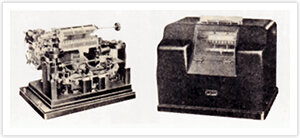Part 4
Part 4: A wartime economy
When the war ended on August 15, 1945, Japan had been on a wartime footing for 15 years. During this time, manufacturers operated under military control, compelled to produce goods primarily for military use. Nevertheless, based on the belief that the path to survival lay in continued research and development and ongoing refinements in its technological capabilities, OKI took great pains to accumulate the technologies that would prove beneficial in the future, while prioritizing requisitions from the army and navy.
Start of OKI as a general manufacturer

OKI planned two publication projects in January 1931 to commemorate the 50th anniversary of its founding. One was Kibataro Oki (published in 1932), which offered an introduction to the life and work of founder Kibataro OKI. The other was OKI Technical Review (published in 1934), a technical periodical intended to introduce research and development activities and new products. This project represented the company's desire to develop as a technology company, a goal since its establishment.
In the first issue of the magazine, Saburo Oshida, Director and Chief Engineer (who later became a managing director, then executive managing director), highlighted the importance of research and development, as captured in the following aphorism: "A single day idled away is regretted for a thousand days." The publication of OKI Technical Review was part of an effort to solidify the groundwork for research and development activities and hinted at OKI's future course as a general manufacturer. The administrative counterpart was the reorganization implemented in the same year the book was published. OKI established separate departments for R&D and engineering and recruited Katsuichiro Kobayashi, an assistant professor of electroacoustics at Tohoku University and a leading expert in weak electric currents, as director of the new research department. Led by Director Kobayashi, the R&D Department began developing radio devices and sonar systems, commercialized a teletypewriter, and launched research on transmission systems. In a path that diverged from such positive decisions, Japan that year stepped onto the course toward war.
Development activities in a time of militarism

With the country increasing focused on war preparations, OKI's production was increasingly diverted to meet military needs. Telecommunications devices were essential for war, and the military expressed high interest in OKI and its capacity to produce and supply such devices from within Japan.
At the request of the army and the navy, OKI set out to produce radio and sonar devices. OKI initially lagged behind others in radio devices. This changed with the establishment in 1925 of Nihon Musen Denshin KK (The Japan Wireless Telegraph Company), a national policy company, and the subsequent appointment of Kakichi Uchida, advisor to OKI, as Nihon Musen Denshin president. OKI thereafter won orders to produce shortwave radio receivers. The technical guidance provided facilitated the cultivation of internal engineers. After the first unit won high acclaim, the radio device entered full-scale production. In 1935, the company established a radio device department and took other steps to strengthen radio device production capabilities, putting itself in position to contribute to radio needs during wartime.
In 1936, the Naval Technical Research Institute, which expressed interest in OKI's research on underwater ultrasonic telecommunication, asked the company to produce an underwater sound locator for submarine detection. This became OKI's first sonar product. OKI thereafter began developing sound detectors capable of detecting sound from targets and sonars that used ultrasonic waves to determine the relative location and direction of vessels, resulting in a rush of orders for such products. The store of technologies accumulated during these years were deployed after the war to develop fish finders and sounding devices for precise depth measurements of rivers, lakes, and dams.
Planting seeds for the postwar years

The research department continued its voluntary activities under the direction of Director Kobayashi, receiving support from management, namely, Saburo Oshida, the Director and Chief Engineer mentioned above. While giving top priority to military needs, Saburo Oshida was sincerely interested in planting the seeds of technologies that would benefit the company after the war. Various research seeds planted in this time of upheaval blossomed after the war.
A prewar issue of OKI Technical Review contains a paper that explored the sensitivity of a telephone transmitter, the study leading to the development after the war of the Type-4 Telephone. Numerous papers on radio telecommunications were published in this journal. While radio research was promoted mainly at the request of the army and the navy, developments based on this research after the war found applications in administrative radio for the police, fire departments, and municipalities, in commercial radios for vessels and taxis, and, then, in multiplexed radio. A 1935 issue of the OKI Technical Review contains a paper on a teletypewriter, which laid the cornerstones for research on its evolution into a data terminal. The start of the war against the United States interrupted development of the prototype; the company could not afford to produce any products other than those for military use.
Nevertheless, these technologies carried over into the postwar years and eventually led to the commercialization of various data terminals and transmission technologies. The commitment to continuing research and to the preservation of the tradition of technology development on the part of various individuals in various positions within the company—for the most part unnamed—established the backbone of OKI's postwar growth.
